
hotline:
17715390137
Tel/Wechat:
18101240246 (Technology)
0512-68565571
Email:mxenes@163.com (Sales Engineer)bkxc.bonnie@gmail.com
Scan the code to follow or search the official account on WeChat:
2D Materials Fronrier After paying attention,
click on the lower right corner to contact us,
Enter enterprise WeChat.
Professional Services Online

When it comes to high-throughput material calculations and material genome experts, it is inevitable to think of Professor Gerbrand Ceder in the United States. Professor Ceder is currently working at the University of California, Berkeley and Lawrence Berkeley National Laboratory (research group website: https://ceder.berkeley.edu/research-areas/). The main research directions are high-throughput computing, data mining, material genome project, lithium-ion batteries, sodium-ion batteries, multivalent batteries, solid-state lithium-ion conductors, and all-solid-state batteries. He has published more than 500 papers in journals including Nature, Science, Nature Mater., Nature Energy, Energy Environ. Sci., Adv. Mater., he has cited more than 50,000 times, and his H-index is 114 (as of 2019) . This article summarizes some of the results of Professor Ceder‘s research group recently published in top international journals, let‘s take a look at the research trends of the big guys.
01
Science: The fast charging mechanism of lithium titanate
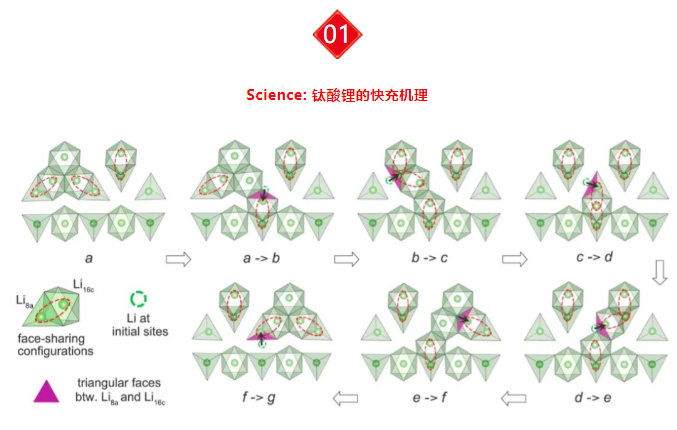
Fast-charge batteries usually use electrode materials that can continuously accommodate lithium ions through solid solution transformation, because solid solution transformation has a lower kinetic energy barrier because of ion diffusion. But one exception is lithium titanate (Li4Ti5O12), which exhibits extraordinary rate performance, which is obviously inconsistent with its two-phase reaction and slow Li diffusion in the two phases. Professor Ceder and Professor Wang Feng of Brookhaven National Laboratory (joint communication) used in-situ electron energy loss spectroscopy to track Li+ migration in real time, revealing that the favorable transmission of Li in Li4+xTi5O12 is caused by the distortion of Li polyhedra along the metastable mesophase. The dynamic path of the two-phase boundary is realized. This work explains that high-rate performance can be achieved through the energy map above the ground state, which is completely different from the dynamic mechanism of the macroscopic phase of the ground state, and provides new opportunities for the search for high-rate electrode materials in the future.
Portal: Gerbrand Ceder & Wang Feng‘s latest Science: See how lithium titanate realizes fast charging of lithium batteries
Kinetic pathways of ionic transport in fast-charging lithium titanate. Science, 2020, 367, 1030-1034. https://doi.org/ 10.1126/science.aax352
02
Nature Materials: The game relationship between thermodynamics and kinetics in the process of material synthesis
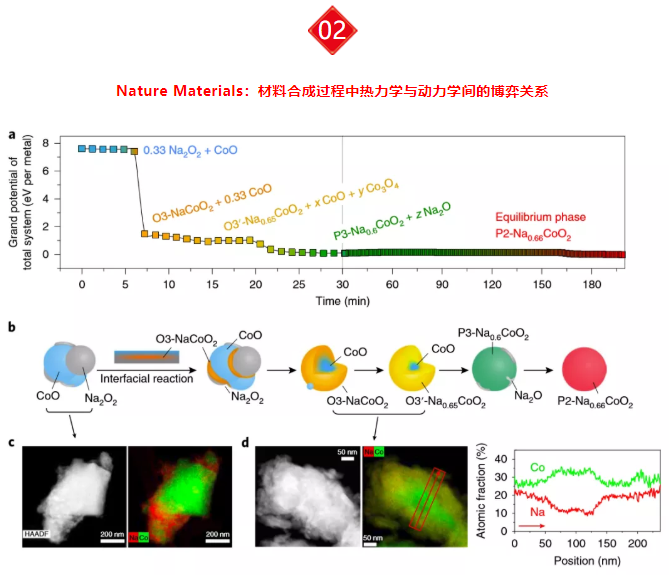
During the synthesis of inorganic materials, the reaction often produces non-equilibrium kinetic by-products instead of thermodynamic equilibrium phases. Therefore, understanding the competitive relationship between thermodynamics and kinetics is the basic step to achieve the targeted synthesis of target materials. Professor Ceder and Dr. Wenhao Sun of Lawrence Berkeley National Laboratory/University of Michigan (Common Communication) used in-situ simultaneous X-ray diffraction to study the multi-level crystallization of double-layer (P2) sodium oxide Na0.67MO2 (M=Co, Mn) path. Before the formation of the balanced double-layer P2 polymorph, a series of rapid non-equilibrium phase transitions of the metastable three-layer O3, O3‘ and P3 phases can be observed. Therefore, a theoretical framework was proposed to rationalize the observed phase changes, indicating that although P2 is an equilibrium phase, the unconstrained reaction of the components between the powder precursors facilitates the formation of a non-equilibrium three-layer mesophase. These insights can guide the selection of precursors and parameters used in the solid-state synthesis of ceramic materials, and promote the disclosure of the complex interaction between thermodynamics and kinetics.
The interplay between thermodynamics and kinetics in the solid-state synthesis of layered oxides. Nature Mater., 2020. DOI: 10.1038/s41563-020-0688-6
03
Nature Energy: Ultra-high power and energy density of some ordered lithium ion cathode materials
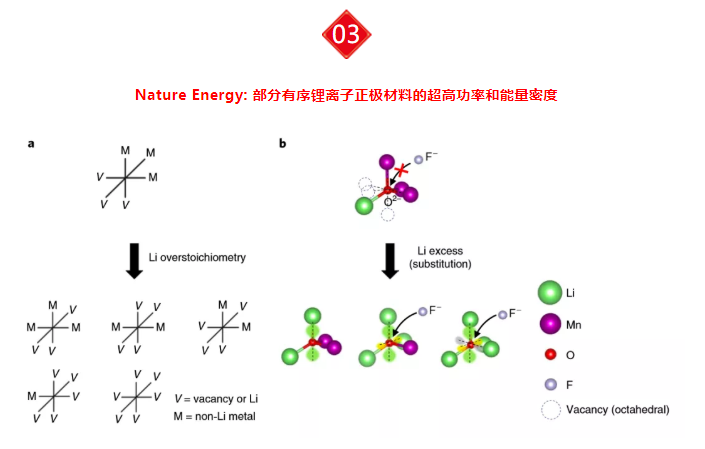
The rapid market development of rechargeable batteries requires electrode materials with high power, high energy and abundant raw materials. The research group of Professor Ceder (corresponding author) found that combining the ordering of some spinel-like cations and the abundant lithium excess can simultaneously achieve fast and close storage capacity. Among them, the overdosing ratio of cations and the partial ordering caused by them are used to reduce the unique phase transition of ordered spinel and obtain higher actual capacity. However, excessive lithium is used in conjunction with fluorine doping to create high lithium mobility. Using this strategy, the final material achieves a specific energy higher than 1100 Wh kg-1, and the discharge rate is as high as 20 A g-1. More importantly, the cathode material obtained from cheap manganese exhibits a rare phenomenon: excellent rate performance and reversible oxygen redox activity coexist. This work confirmed the great potential of cathode materials between ordered and disordered structures.
Portal: Professor Ceder Nature Energy: 1100Wh/Kg, an economical lithium battery positive electrode with a structure between completely ordered and disordered
Ultrahigh power and energy density in partially ordered lithium-ion cathode materials. Nature Energy, 2020. DOI:10.1038/s41560-020-0573-1
04
Nature Reviews Materials: Understanding the interface stability in solid-state batteries
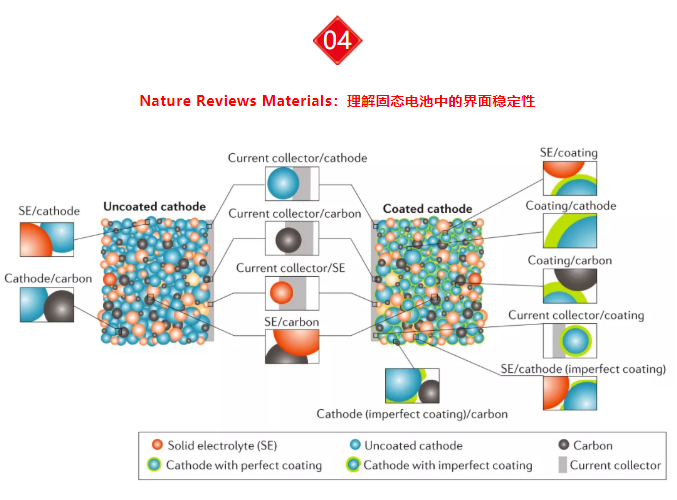
Compared with traditional lithium-ion batteries, solid-state batteries using solid-state electrolytes (SSBs) can provide better safety, higher energy and power density. At present, there are two key bottlenecks in the development of SSBs: high ionic conductivity and stable interface. Although the first goal has been achieved in many solid ion conductors, the high impedance at many solid/solid interfaces is still extremely challenging. The research group of Professor Ceder (corresponding author) reviewed the experimental findings of various solid electrolytes and correlated them with theoretical calculations. It aims to deeply understand the interface reaction in solid-state batteries and provide ideas for future interface design work.
Portal: Overview of Nature Reviews Materials by Ceder Team丨Using theoretical calculations to understand the interface stability of solid-state batteries
Understanding interface stability in solid-state batteries. Nat. Rev. Mater., 2020. DOI: 10.1038/ s41578-019-0157-5
05
Advanced Energy Materials: High-energy NASICON cathode materials for sodium ion batteries
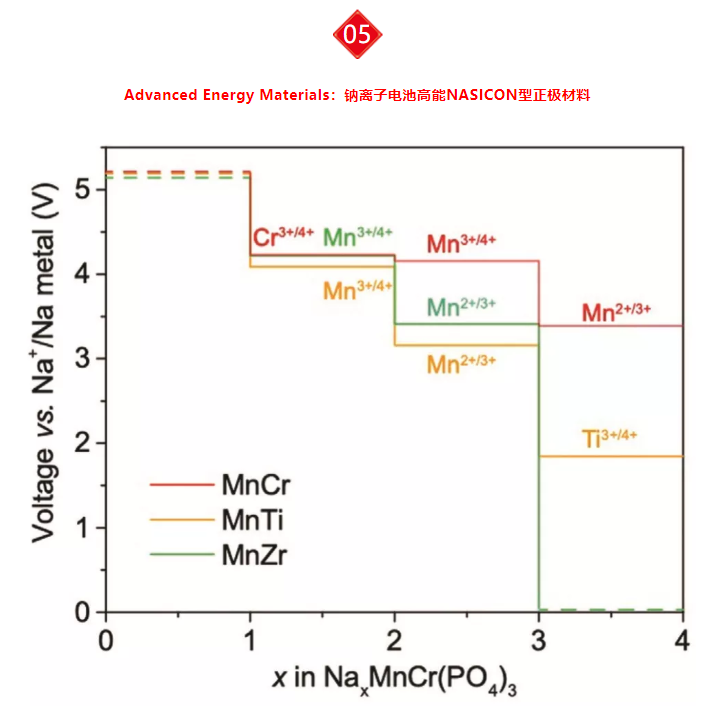
In the past ten years, sodium-ion batteries have been widely studied in large-scale grid storage applications as a low-cost alternative to lithium-ion batteries. However, the development of high-energy cathodes remains a major challenge. Materials with a polyanion framework, such as the Na superionic conductor (NASICON) structure positive electrode with the molecular formula NaxM2(PO4)3, have attracted considerable attention because of their stable 3D crystal structure and high operating potential. Professor Ceder and Yan Wang of Samsung Research Institute of the United States (joint communication) reported a new type of NASICON compound Na4MnCr(PO4)3, which uses high voltage Mn2+/3+ (3.5 V), Mn3+/4+ (4.0 V) and Cr3+/ 4+ (4.35 V) transition metal redox discharge, the specific capacity is as high as 130 mAh g-1. In addition, Na4MnCr(PO4)3 also demonstrated high rate performance (97 mAh g-1 at 5C) and excellent full temperature performance. In-situ X-ray diffraction and simultaneous X-ray diffraction analysis revealed the reversible structural changes of the material during charge and discharge.
A high-energy NASICON-type cathode material for Na-ion batteries. Adv.Energy Mater., 2020. DOI: 10.1002/aenm.201903968
06
Adv. Energy Mater.: The influence of fluorination in the anode of disordered rock salt lithium-ion battery on lithium transport and short-range order

Disordered rock salt (DRX) lithium-ion battery cathode materials have high energy density and do not rely on limited mineral resources. Fluorine doping is a key contributing factor to increase its cycle life and energy density. Due to the strong Li-F interaction, F is also expected to improve the order of short-range cations in the material, which is important for Li ion transport. The research group of Professor Ceder (corresponding author) combined density functional theory and Monte Carlo simulation calculations to study the influence of Li-F short-range order in DRX materials on Li infiltration and diffusion. Simulation results show that F doping is often beneficial at sufficiently high concentrations, and can even promote percolation in compounds without excess Li, enabling it to bind more transition metal redox capacity and higher energy density. When the F content is less than 15%, whether its effect is beneficial or harmful depends on the short-range order structure inherent in the fluoride-free oxide. A large number of simulations can be used to obtain a graph showing the trade-off between transition metal capacity, Li transport, and synthesis feasibility.
Effect of fluorination on lithium transport and short-range order in disordered-rocksalt-type lithium-ion battery cathodes. Advanced Energy Materials, 2020. DOI: 10.1002/aenm.201903240
Reply to "Submit" in the backstage of the official account, and you can promote your work on this official account.
Huasuo Technology specializes in theoretical calculation simulation services. It is the only computing service company with VASP commercial copyright and its computing service qualifications and a full-time technical team. It provides raw data that can be traced throughout the entire process to ensure that your data is accurate and legal and reject academic risks.
At present, we have completed more than 500 service cases, and client work has been published in well-known journals such as JACS, Angew, AM, AEM, Nano Energy, Nature sub-journals, and Science sub-journals.
This information is sourced from the Internet for academic exchange only. If there is any infringement, please contact us to delete it immediately.

| Reminder: Beijing Beike New Material Technology Co., Ltd. supplies products only for scientific research, not for humans |
| All rights reserved © 2019 beijing beike new material Technology Co., Ltd 京ICP备16054715-2号 |